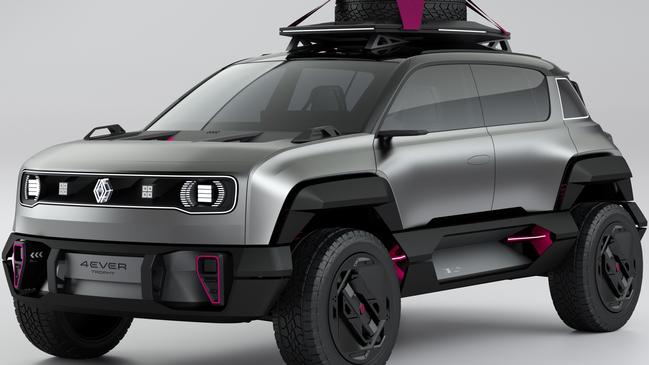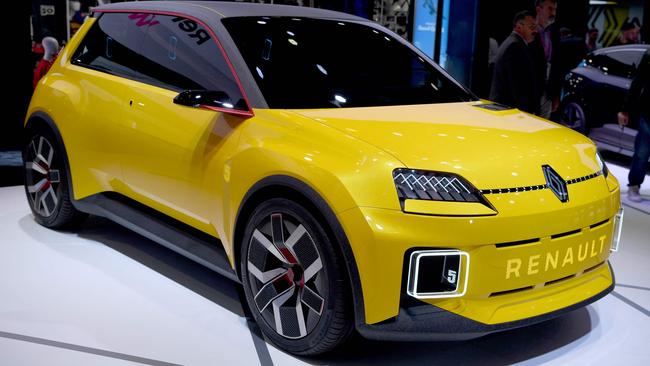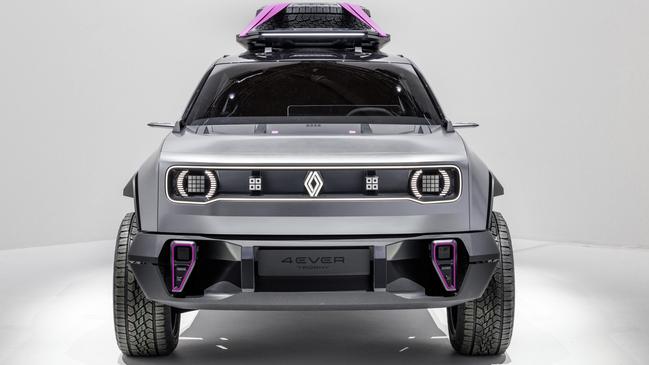Renault 4Ever Trophy concept points to affordable EV
They’re cute, affordable and compact. And they could be the vehicles that will convert sceptical Aussies to the advantages of electric cars.

HiTech
Don't miss out on the headlines from HiTech. Followed categories will be added to My News.
Strip away the Renault 4Ever Trophy concept’s outdoorsy add-ons and you’re looking at a small sub-$40,000 SUV EV due for production in 2025.
Revealed recently at a pared-down Paris motor show, it joins last year’s Renault 5 Prototype concept as a pointer to the French brand’s ambition to make EVs affordable. The Renault 5 small hatchback EV is scheduled for production in 2024.
“We see potential for both concepts in Australia,” said Glen Sealey, Renault Australia’s general manager for importer Ateco.
“We have our hands up for all new products from Renault made available in right-hand drive.”

The 4 and 5 definitely will be built in right-hand drive. The Renault brand’s chief operating officer Fabrice Cambolive confirmed they were intended for sale “on all continents”.
Including Australia?
“It should be.”
Renault said the 4Ever concept was close to the production design, with the fancy cladding stripped away.
“We camouflaged it a lot,” said Renault design chief Gilles Vidal, referring to the 4Ever Trophy concept’s high-riding suspension, deep sills, big wheels, roof-mounted spare and more.
“If you put this back to the floor, with normal wheels and less extreme cladding,” the designer said, you’re looking at what Renault plans to build.

“It’s not just a little bit close; it is actually production.”
The same applies to the 5 Prototype, which is a “95 per cent” accurate guide to the production version.
“It’s only a matter of a few centimetres,” he said. “It’s really the same car.”
Vidal said both designs were “retro-futuristic”.
Their looks echo classic models from the company’s past, the 4L from the ’60s and the 5 from the ’70s, but also have a modern flavour.
“Even if you don’t care about the history of the 4L, or you don’t know the car at all, it
needs to be appealing for what it is, not for what it connects to in the past,” Vidal said.
Renault Group engineering boss Gilles Le Borgne detailed how the price of the 4 and 5 EVs would be kept low.

Both will be front-drive and use many parts from inexpensive internal-combustion engine models already in production. Heating, ventilation and airconditioning systems, seat frames, front axles and windscreen wipers, for example. And the two small Renault models will share these with the new Micra EV that Nissan is developing. Both companies are part of the giant Renault Nissan Mitsubishi Alliance, one of the world’s largest car makers.
The battery packs of the small EVs will all use affordable cell chemistry. And the cells will be manufactured close by the car assembly lines, reducing logistics costs.
Renault will offer a choice between 40kWh and 52kWh battery packs in the 4 and 5 EVs.
The smaller will have a driving range of “above 300km”, Le Borgne says, while the larger pack will be good for more than 400km.
“This is reasonable,” he argues.

The cars will be equipped to recharge at up to 11kW from an AC wallbox and 130kW from a DC fast charger.
“For this type of car I think that’s a very good package.”
Renault’s cost-reduction measures mean prices for the 4 and 5 in Europe in the €20,000 to €25,000 range, according to Le Borgne.
This translates to as low as $30,000 to almost $40,000 in Australia. These are the kind of prices expected from unknown Chinese EV makers, not a European brand.
“You know the Renault brand is a pop brand, a popular brand, and we need to make mobility affordable,” Le Borgne said. “That’s really our role.”
The engineer was very confident both the small EVs would be very successful, but he wasn’t taking all the credit. Renault’s designers deserved an even larger share.
“They are cute,” Le Borgne said. “Styling is still the first reason to buy.”
Originally published as Renault 4Ever Trophy concept points to affordable EV


